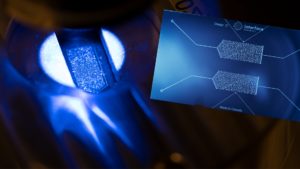As the oil and gas industry rethinks its approach to minimum miscibility pressure (MMP) measurements, Interface Fluidics is pleased to announce the development and deployment of a first-of-its-kind portable testing system.
Showcasing Interface’s unique, nanotechnology-enabled, microfluidic MMP screening, this device will support the optimization and de-risking of carbon capture, utilization, and storage (CCUS) processes.
By calibrating the blending of multiple produced gas streams and industrial CO2, Interface will provide operators with access to rapid, low-cost, high-quality MMP data.
This will be particularly valuable for gas flooding of low-pressure reservoirs as a small change in injected gas composition can push the system past the miscibility threshold, significantly reducing reservoir yield. The impact on MMP depends on the impurity in question, and since injected streams can include many of them, high throughput measurements are important.
In conventional slim tube testing, measurements are often taken once, and data is interpolated when conditions change. Using Interface’s category-leading measurement process, companies will be able to gather numerous high-resolution MMP points across various injected gas compositions. The measurements can then be used to tune or ground reservoir models to gain more accurate insights into underground fluid behavior.
Additional advantages of Interface’s verified MMP testing technology include:
- 95% reduction in time per measurement
- 50% lower cost
- 99% smaller sample volume
- 10-20X increase in the number of measurements
Making waves
The first objective for this deployable system is a year-long project involving a set of 20 MMP tests. The tests will be conducted at reservoir temperature and pressure with sour oil containing H2S. Impurities that will be examined include H2, H2S, N2, C1 to C6, and Ar.
Interface will measure the MMP and investigate transition zones, flow dynamics of CO2 in porous media, and the impact of soak time on recovery performance. Results will provide a sensitivity analysis for multiple impurities and concentrations, and their impact on MMP to ensure miscibility is maintained.
The people behind the product
The work needed to make this project possible required talent from several teams at Interface. The mechanical team worked to transform the existing lab bench into a compact portable unit. Company Co-Founder Tom de Haas worked with engineers Dave O’Brien and Lance Baschuk on the portable system, ensuring the piece would meet the needs for current tests and allow room for future advancement.
For the first deployment, the actual tests and analysis will be conducted by the operations team. Drs. Ali Abedini and Zhenbag Qi partnered with PVT analyst Shawn Worthing to run the experiments, analyze the data, and compile results.
Advantages in miniature
By working with Interface, clients will be able to make use of rapid, low-cost data concerning how its gas streams interact with oil underground. They’ll also better understand changing reservoir conditions, which could inform facility design and capital allocation decisions.
A pivotal impact of this project comes through its potential contribution to a reduction in barriers facing future CO2 EOR and sequestration projects in Canada and the world.
This prototype also marks an essential stage in the commercialization of Interface’s MMP testing. Once we demonstrate that informing gas injection strategy with point-of-care rapid MMP testing is effective, we’ll be able to implement this technology in miscible gas flood operations around the world. Additional markets for this testing already exist in Texas, North Sea, and Middle Eastern reservoirs.
This project complements the work being done through Interface’s JIP with Equinor and ExxonMobil to accelerate the deployment of its revolutionary, compact, rapid fluid screening equipment for the oil and gas industry.




